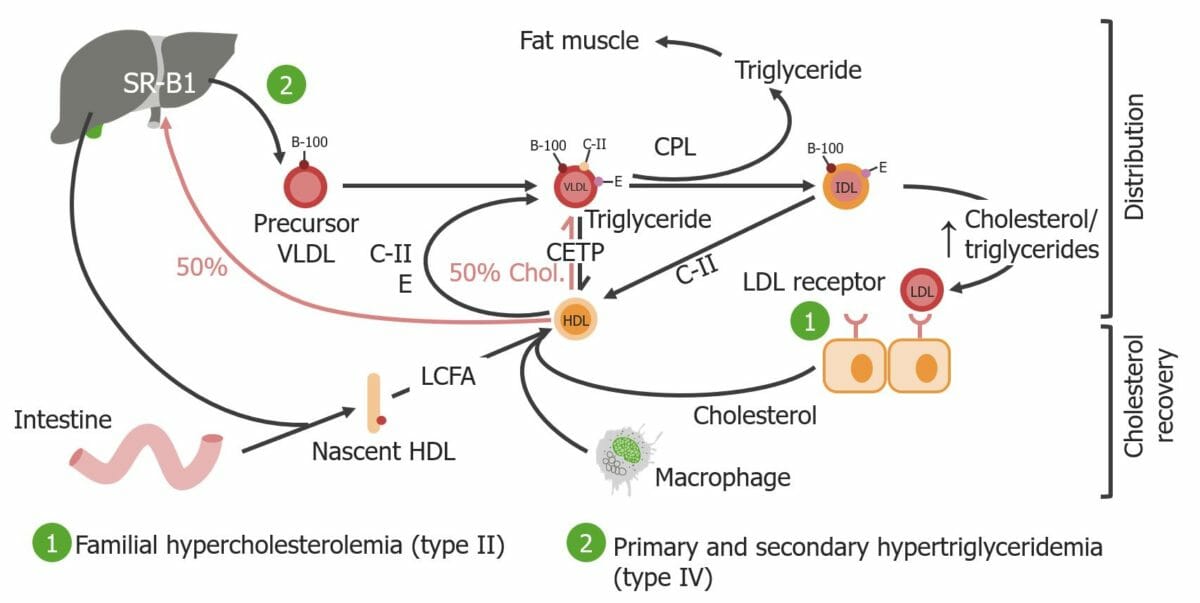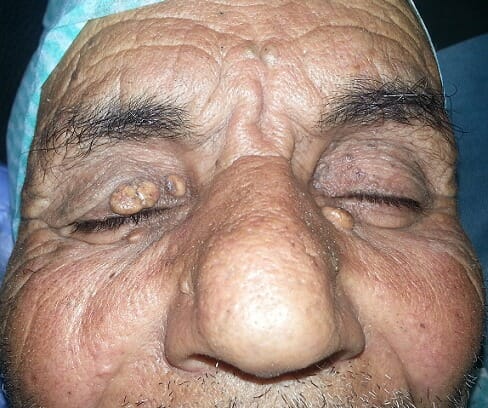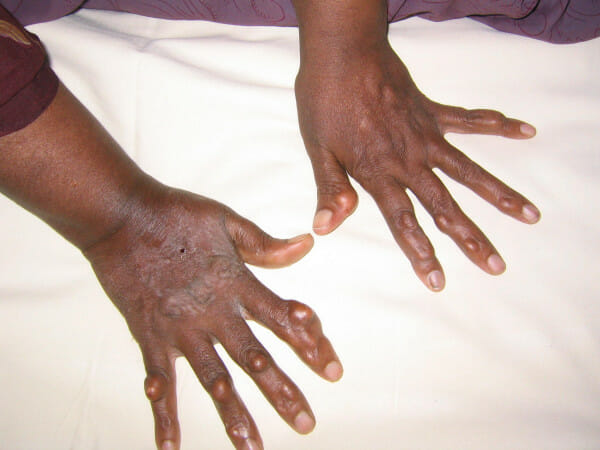An abnormal amount of lipids in blood is called dyslipidemia, which includes abnormal levels of cholesterol, triglycerides, and/or lipoproteins. Dyslipidemia may be primary (familial) or secondary (acquired). Both primary and secondary causes can lead to the development of premature atherosclerotic cardiovascular disease (ASCVD). Familial causes are classified according to the Fredrickson system, which looks into the pathology and the lipids that are elevated. Certain types do not increase the risk of premature atherosclerotic disease but still impact overall cardiac risk and chance of cardiovascular events in the future. Screening, early diagnosis, and strict control and management are the keys to prevention of cardiovascular events.
Last updated: Jun 3, 2025
Dyslipidemia: abnormal amounts of lipids Lipids Lipids are a diverse group of hydrophobic organic molecules, which include fats, oils, sterols, and waxes. Fatty Acids and Lipids in the blood
Lipid disorders Lipid disorders An abnormal amount of lipid in blood is called dyslipidemia, which includes abnormal levels of cholesterol, triglycerides, and/or lipoproteins. Dyslipidemia may be primary (familial) or secondary (acquired). Both primary and secondary causes can lead to the development of premature cardiovascular (atherosclerosis) disease. Lipid Disorders are due to a combination of diet and lifestyle habits coupled with a genetic predisposition.
Causes of dyslipidemia can be divided into primary (familial) and secondary (acquired) causes.
Primary causes:
Secondary (acquired) causes:
| Type | Condition, mode of inheritance ( AD AD The term advance directive (AD) refers to treatment preferences and/or the designation of a surrogate decision-maker in the event that a person becomes unable to make medical decisions on their own behalf. Advance directives represent the ethical principle of autonomy and may take the form of a living will, health care proxy, durable power of attorney for health care, and/or a physician’s order for life-sustaining treatment. Advance Directives, AR AR Aortic regurgitation (AR) is a cardiac condition characterized by the backflow of blood from the aorta to the left ventricle during diastole. Aortic regurgitation is associated with an abnormal aortic valve and/or aortic root stemming from multiple causes, commonly rheumatic heart disease as well as congenital and degenerative valvular disorders. Aortic Regurgitation), lipid abnormality | Pathology | Notes |
|---|---|---|---|
| I |
Familial hyperchylomicronemia
Familial Hyperchylomicronemia
Lipid Disorders (
AR
AR
Aortic regurgitation (AR) is a cardiac condition characterized by the backflow of blood from the aorta to the left ventricle during diastole. Aortic regurgitation is associated with an abnormal aortic valve and/or aortic root stemming from multiple causes, commonly rheumatic heart disease as well as congenital and degenerative valvular disorders.
Aortic Regurgitation) Elevated chylomicrons |
Deficiency in LPL or ApoC-II |
|
| IIa |
Familial hypercholesterolemia
Familial hypercholesterolemia
Lipid Disorders(FH) (
AD
AD
The term advance directive (AD) refers to treatment preferences and/or the designation of a surrogate decision-maker in the event that a person becomes unable to make medical decisions on their own behalf. Advance directives represent the ethical principle of autonomy and may take the form of a living will, health care proxy, durable power of attorney for health care, and/or a physician’s order for life-sustaining treatment.
Advance Directives) Elevated LDL |
Mutation Mutation Genetic mutations are errors in DNA that can cause protein misfolding and dysfunction. There are various types of mutations, including chromosomal, point, frameshift, and expansion mutations. Types of Mutations in PCSK-9, defective LDL receptors Receptors Receptors are proteins located either on the surface of or within a cell that can bind to signaling molecules known as ligands (e.g., hormones) and cause some type of response within the cell. Receptors or ApoB-100 |
|
| IIb |
Familial combined hypercholesterolemia
Familial Combined hypercholesterolemia
Lipid Disorders (
AD
AD
The term advance directive (AD) refers to treatment preferences and/or the designation of a surrogate decision-maker in the event that a person becomes unable to make medical decisions on their own behalf. Advance directives represent the ethical principle of autonomy and may take the form of a living will, health care proxy, durable power of attorney for health care, and/or a physician’s order for life-sustaining treatment.
Advance Directives) Elevated VLDL and LDL |
|
|
| III |
Familial hyperlipoproteinemia
Familial hyperlipoproteinemia
Lipid Disorders (
AR
AR
Aortic regurgitation (AR) is a cardiac condition characterized by the backflow of blood from the aorta to the left ventricle during diastole. Aortic regurgitation is associated with an abnormal aortic valve and/or aortic root stemming from multiple causes, commonly rheumatic heart disease as well as congenital and degenerative valvular disorders.
Aortic Regurgitation) Remnants of VLDL and chylomicrons |
Defective ApoE |
|
| IV |
Familial hypertriglyceridemia
Familial hypertriglyceridemia
Lipid Disorders (
AD
AD
The term advance directive (AD) refers to treatment preferences and/or the designation of a surrogate decision-maker in the event that a person becomes unable to make medical decisions on their own behalf. Advance directives represent the ethical principle of autonomy and may take the form of a living will, health care proxy, durable power of attorney for health care, and/or a physician’s order for life-sustaining treatment.
Advance Directives) Elevated VLDL |
Excessive VLDL production by the liver Liver The liver is the largest gland in the human body. The liver is found in the superior right quadrant of the abdomen and weighs approximately 1.5 kilograms. Its main functions are detoxification, metabolism, nutrient storage (e.g., iron and vitamins), synthesis of coagulation factors, formation of bile, filtration, and storage of blood. Liver: Anatomy |
|
| V |
Mixed hyperlipidemia
Mixed Hyperlipidemia
Lipid Disorders (
AR
AR
Aortic regurgitation (AR) is a cardiac condition characterized by the backflow of blood from the aorta to the left ventricle during diastole. Aortic regurgitation is associated with an abnormal aortic valve and/or aortic root stemming from multiple causes, commonly rheumatic heart disease as well as congenital and degenerative valvular disorders.
Aortic Regurgitation) Elevated chylomicrons and VLDL |
Defective ApoA5 |
|

Schematic depiction of the Fredrickson classification types I and III
FFA: free fatty acid
ApoB-48: apolipoprotein-B-48
ApoC-II: apolipoprotein C-II
ApoE: apolipoprotein E
LPL: lipoprotein lipase

Schematic depiction of Fredrickson classification types II and IV
Image by Lecturio.Many individuals with hyperlipidemia and hypertriglyceridemia Hypertriglyceridemia A condition of elevated levels of triglycerides in the blood. Lipid Disorders are asymptomatic, without symptoms and signs (other than those listed below). The most common clinical manifestation of lipid disorders Lipid disorders An abnormal amount of lipid in blood is called dyslipidemia, which includes abnormal levels of cholesterol, triglycerides, and/or lipoproteins. Dyslipidemia may be primary (familial) or secondary (acquired). Both primary and secondary causes can lead to the development of premature cardiovascular (atherosclerosis) disease. Lipid Disorders is ASCVD.[17,23]

An elderly patient with yellow-tan deposits around the eyelids, most likely indicative of xanthelasma
Image: “Les différentes lésions jaunâtres au niveau des deux paupières en rapport avec le xanthélasma” by Elghazi, T. and Hafidi, Z. License: CC BY 2.0
Multiple xanthomas on hands
Image: “Xanthomas” by Kumar, A.A. et al. License: CC BY 2.0
Four representative slides of corneal arcus:
Arcus deposits tend to start at 6 and 12 o’clock and fill in until becoming completely circumferential.
Dyslipidemia is defined as lipid values associated with an increased risk of and/or presence of disease for which the initiation of lipid-lowering therapy will be of benefit. There is controversy regarding the age at which to start screening Screening Preoperative Care, and guidelines for children and young adults vary. The recommendations listed below are based on the US Preventive Services Task Force (USPSTF) and the American Heart Association American Heart Association A voluntary organization concerned with the prevention and treatment of heart and vascular diseases. Heart Failure guidelines.
| Lipid | Desirable value |
|---|---|
| Total cholesterol Cholesterol The principal sterol of all higher animals, distributed in body tissues, especially the brain and spinal cord, and in animal fats and oils. Cholesterol Metabolism |
|
| HDL cholesterol Cholesterol The principal sterol of all higher animals, distributed in body tissues, especially the brain and spinal cord, and in animal fats and oils. Cholesterol Metabolism |
|
| LDL cholesterol Cholesterol The principal sterol of all higher animals, distributed in body tissues, especially the brain and spinal cord, and in animal fats and oils. Cholesterol Metabolism |
|
| TGs |
|
The aim of management is to reduce the risk of cardiovascular disease including heart attack Heart attack Mi is ischemia and death of an area of myocardial tissue due to insufficient blood flow and oxygenation, usually from thrombus formation on a ruptured atherosclerotic plaque in the epicardial arteries. Clinical presentation is most commonly with chest pain, but women and patients with diabetes may have atypical symptoms. Myocardial Infarction and stroke.[8]
| Therapy intensity | Typical medication choice and dose (adult) |
|---|---|
| High intensity |
|
| Moderate intensity |
|
| Low intensity |
|